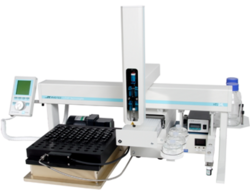Monitoring of Micro-dissolution
From LEAP

| Monitoring of Dissolved Product |
| Application Type | |
| Process Monitoring | |
| Application ID | |
| ProcessMonitoring1001 | |
| Description | |
| Sampling of slow release drugs from micro-dissoultion vessels |
Overview
Dissolution testing of slow-release devices, for example small, polymer coated springs or coils which can be implanted inside the human body and release their drugs over a period of many months or even years. It is applicable to any customer who is developing or manufacturing these devices. This type of testing is a necessary part of the development and or QC process. The objective is to carefully measure the release rate of the drug from the device in-vitro over a period of time. Results are then correlated with data collected in animals.
Significant Markets
This application is ideal for those labs who wish to perform dissolution testing in small vessels. Samples or devices are normally held in vials incubated and shaken for prolonged periods and elution volumes removed and tested periodically. Elements of this application could be applied to labs requiring any type of sample treatments at timed intervals. It also involves storing data about each sample in Excel and protecting the devices from contact with the sampling needle
What is a Dissolution Testing experiment?
The testing procedure is quite simple. Vials containing the devices are filled with a buffer solution. They are loaded into a special heated and shaking tray. A timer is started. At specified intervals the buffer is removed, a portion of it saved for later analysis, the rest discarded, and the vials replenished with fresh buffer.
Despite its simplicity, this process requires the manual sampling and testing of hundreds of vials at very carefully measured time intervals over a period of days. It is a very tedious operation which requires technicians to be in and out of the lab for hours doing a very mundane job – a classic candidate for automation. It was important that any automation solution did not damage the surface of the devices. There were no existing options to automate this process before the customer approached LEAP.
LEAPS Approach
The PAL in combination with the LEAP Shell makes a very effective and flexible workstation.
We were able to design and provide a solution which met the following challenges from the customer:
1. Exchanging large volumes of liquid from sealed vials. This requires overcoming vacuum/pressure differentials.
2. Protect the slow-release devices from contact and potential damage by the sampling needle. This was achieved using a specially designed vial insert.
3. Shaking and incubating a large number of sample vials (>20). We were able to source a suitable heated shaking table for their vials from a third party vendor.
4. Setting up a sampling schedule in the software which would span over several days if necessary. Only possible with the LEAP Shell.
5. Provide the flexibility to change the sample batch size and sampling intervals.
6. Record the actual sampling times to a data file – compare actual time with expected time and report a difference.
Photos
Contact LEAP
Keywords: Mini Dissolution, Slow release, timed-sampling, Heating, Shaking,

